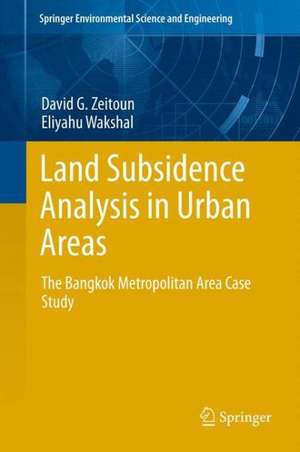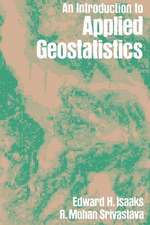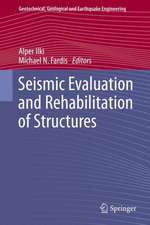Land Subsidence Analysis in Urban Areas: The Bangkok Metropolitan Area Case Study: Springer Environmental Science and Engineering
Autor David G. Zeitoun, Eliyahu Wakshalen Limba Engleză Hardback – 4 ian 2013
1. Construction of buildings and streets adds weight to the region causing additional soil deformations.
2. Often the regions have to be drained in order to be occupied. This results in lowering of the water table and leads to hydro-compaction.
3. Often the groundwater is used as a source of water for both human consumption and industrial use.
4. Levees and dams are often built to prevent or control flooding.
Earth fissures caused by ground failure in areas of uneven or differential compaction have damaged buildings, roads and highways, railroads, flood-control structures and sewer lines. As emphasized by Barends , "in order to develop a legal framework to claims and litigation, it is essential that direct and indirect causes of land subsidence effects can be quantified with sufficient accuracy from a technical and scientific point of view."
Most existing methods and software applications treat the subsidence problem by analyzing one of the causes. This is due to the fact that the causes appear at different spatial scales. For example, over-pumping creates large scale subsidence, while building loading creates local subsidence/consolidation only.
Then, maximum permissible land subsidence (or consolidation) is a constraint in different management problems such as: groundwater management, planning of town and/or laws on building construction. It is, therefore, necessary to quantify the contribution of each cause to soil subsidence of the ground surface in cities urban area.
In this text book, we present an engineering approach based on the Biotsystem of equations to predict the soil settlement due to subsidence, resulting from different causes. Also we present a case study of The Bangkok Metropolitan Area (BMA).
| Toate formatele și edițiile | Preț | Express |
|---|---|---|
| Paperback (1) | 782.57 lei 6-8 săpt. | |
| SPRINGER NETHERLANDS – 18 iun 2015 | 782.57 lei 6-8 săpt. | |
| Hardback (1) | 653.14 lei 6-8 săpt. | |
| SPRINGER NETHERLANDS – 4 ian 2013 | 653.14 lei 6-8 săpt. |
Preț: 653.14 lei
Preț vechi: 768.40 lei
-15% Nou
Puncte Express: 980
Preț estimativ în valută:
124.99€ • 135.72$ • 104.99£
124.99€ • 135.72$ • 104.99£
Carte tipărită la comandă
Livrare economică 22 aprilie-06 mai
Preluare comenzi: 021 569.72.76
Specificații
ISBN-13: 9789400755055
ISBN-10: 9400755058
Pagini: 328
Ilustrații: XVIII, 307 p.
Dimensiuni: 155 x 235 x 23 mm
Greutate: 0.77 kg
Ediția:2013
Editura: SPRINGER NETHERLANDS
Colecția Springer
Seria Springer Environmental Science and Engineering
Locul publicării:Dordrecht, Netherlands
ISBN-10: 9400755058
Pagini: 328
Ilustrații: XVIII, 307 p.
Dimensiuni: 155 x 235 x 23 mm
Greutate: 0.77 kg
Ediția:2013
Editura: SPRINGER NETHERLANDS
Colecția Springer
Seria Springer Environmental Science and Engineering
Locul publicării:Dordrecht, Netherlands
Public țintă
GraduateCuprins
Introduction.- The subsidence phenomenon throughout the world.- Mechanical modeling of porous media.- Fundamentals of teh consolidation theory for soils.- Biot's theory of consolidation.- The numerical solution of the Biot equations.- General software.- A case study: the Bangkok plain.- Conclusions.- Index
Textul de pe ultima copertă
Cities built on unconsolidated sediments consisting of clays, silt, peat, and sand, are particularly susceptible to subsidence. Such regions are common in delta areas, where rivers empty into the oceans, along flood plains adjacent to rivers, and in coastal marsh lands. Building cities in such areas aggravates the problem for several reasons:
1. Construction of buildings and streets adds weight to the region causing additional soil deformations.
2. Often the regions have to be drained in order to be occupied. This results in lowering of the water table and leads to hydro-compaction.
3. Often the groundwater is used as a source of water for both human consumption and industrial use.
4. Levees and dams are often built to prevent or control flooding.
Earth fissures caused by ground failure in areas of uneven or differential compaction have damaged buildings, roads and highways, railroads, flood-control structures and sewer lines. As emphasized by Barends , "in order to develop a legal framework to claims and litigation, it is essential that direct and indirect causes of land subsidence effects can be quantified with sufficient accuracy from a technical and scientific point of view."
Most existing methods and software applications treat the subsidence problem by analyzing one of the causes. This is due to the fact that the causes appear at different spatial scales. For example, over-pumping creates large scale subsidence, while building loading creates local subsidence/consolidation only.
Then, maximum permissible land subsidence (or consolidation) is a constraint in different management problems such as: groundwater management, planning of town and/or laws on building construction. It is, therefore, necessary to quantify the contribution of each cause to soil subsidence of the ground surface in cities urban area.
In this text book, we present an engineering approach based on the Biotsystem of equations to predict the soil settlement due to subsidence, resulting from different causes. Also we present a case study of The Bangkok Metropolitan Area (BMA).
1. Construction of buildings and streets adds weight to the region causing additional soil deformations.
2. Often the regions have to be drained in order to be occupied. This results in lowering of the water table and leads to hydro-compaction.
3. Often the groundwater is used as a source of water for both human consumption and industrial use.
4. Levees and dams are often built to prevent or control flooding.
Earth fissures caused by ground failure in areas of uneven or differential compaction have damaged buildings, roads and highways, railroads, flood-control structures and sewer lines. As emphasized by Barends , "in order to develop a legal framework to claims and litigation, it is essential that direct and indirect causes of land subsidence effects can be quantified with sufficient accuracy from a technical and scientific point of view."
Most existing methods and software applications treat the subsidence problem by analyzing one of the causes. This is due to the fact that the causes appear at different spatial scales. For example, over-pumping creates large scale subsidence, while building loading creates local subsidence/consolidation only.
Then, maximum permissible land subsidence (or consolidation) is a constraint in different management problems such as: groundwater management, planning of town and/or laws on building construction. It is, therefore, necessary to quantify the contribution of each cause to soil subsidence of the ground surface in cities urban area.
In this text book, we present an engineering approach based on the Biotsystem of equations to predict the soil settlement due to subsidence, resulting from different causes. Also we present a case study of The Bangkok Metropolitan Area (BMA).
Caracteristici
Presents an integrative method based on both hydrology and soil mechanics Contains exercises with each chapter in the soil deformation part of the book Presents the state of the art in computational methods of subsidence Includes a case study of the Bangkok metropolitan area



























